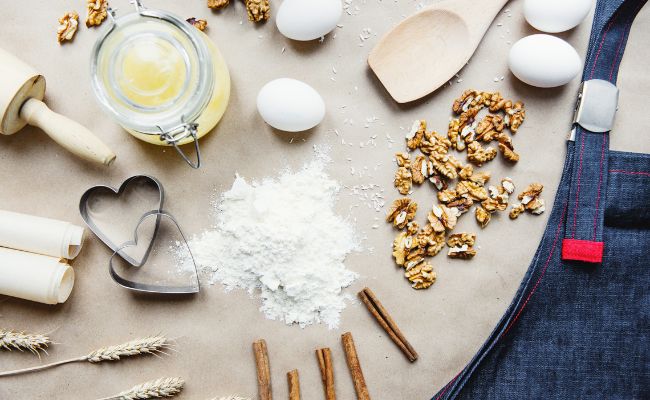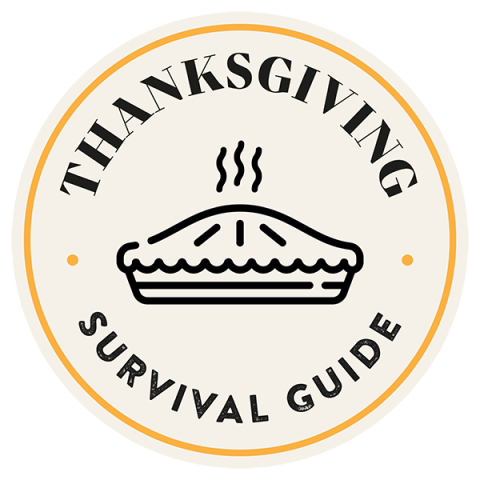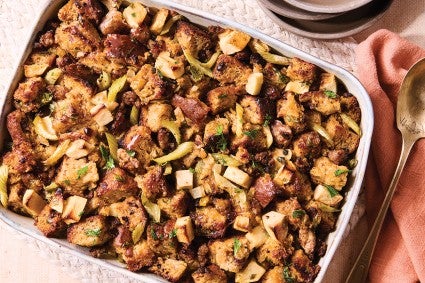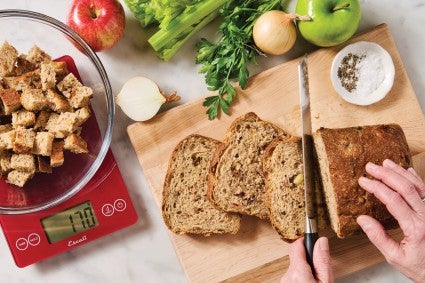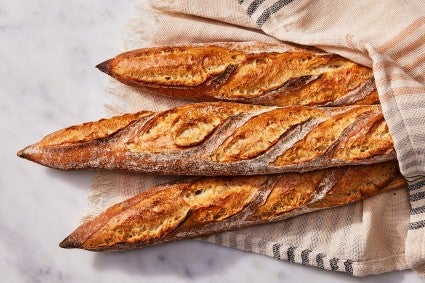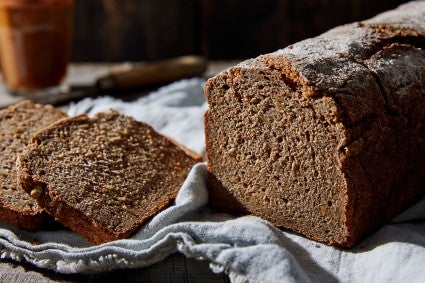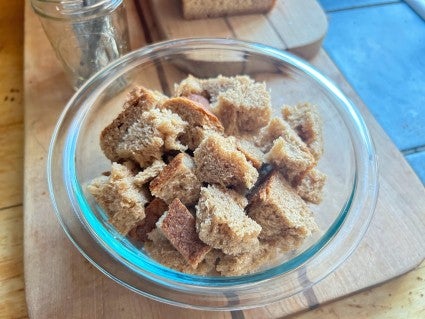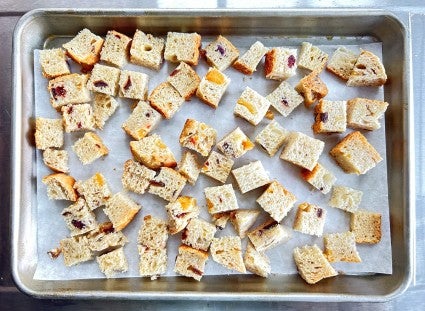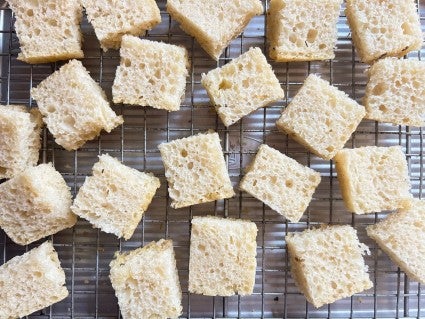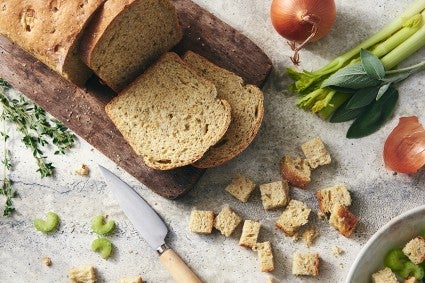Baking trials: What is the best bread for stuffing?
Stuffing is as a lot part of the usual Thanksgiving dinner as cranberry sauce and inexperienced bean casserole. Heat, fragrant, and bread-forward, it’s consolation meals at its finest.
Stuffing combine is on the market on the grocery retailer, nonetheless by forgoing the packaged combine and preparing your personal stuffing from scratch, you’ll open a world of scrumptious alternate choices.
Since bread is its key side, how do you determine what is the best bread to make the most of for stuffing? If a recipe merely requires “1 pound of bread” (with no information concerning type, diploma of staleness, or the dimensions and kind of the lower or torn devices), what then?
Correct proper right here’s methods to resolve the simplest bread for stuffing and techniques to position collectively it.
The best bread for stuffing: type
If the stuffing recipe you’ve chosen is laced with fairly a number of add-ins (nuts, dried fruit, sausage, oysters, mushrooms), it is vulnerable to be finest to resolve on a elementary bread that gained’t compete with completely totally different flavors, equal to a plain white or mild multigrain loaf.
Nonetheless when it’s a extra standard recipe (one which accommodates butter, onions, celery, herbs, and little else) it’s high-quality to pick a extra full-flavored bread, like this Apricot, Raisin & Pecan Bread or Fruited Sourdough Sandwich Bread. (Sourdough loaves may be a wonderful selection as long as they aren’t nice bitter, which might add a distractingly robust type to stuffing.)
The best bread for stuffing: texture
Earlier type, you furthermore want to ponder the feel of your bread. We examined numerous breads utilizing our Apple and Sausage Stuffing recipe, and listed beneath are our findings:
Artisan-style bread (e.g., baguettes, focaccia) (helpful): Crusty artisan-style breads are usually a wide variety for stuffing; they’re generally innately flavorful attributable to longer fermentation, nonetheless that type is straightforward sufficient that they complement any seasoning or add-in.
One difficulty to be careful for: The “holier” the bread, the extra attainable it’s to point out into mushy in stuffing. Bread with a extraordinarily open texture merely isn’t substantial sufficient to provide the compulsory stability of liquid to regular, and usually has a excessive crust to crumb ratio. Must you happen to’re going to make the most of an artisan-style bread, it have to be close-textured fairly than nice holey.
Enriched bread (e.g., brioche, challah): These breads, with their higher fats content material materials supplies, are generally tender and moist, with texture starting from close-grained to fairly open relying on what recipe you observe. In case your loaf may be very close-grained, lower it into smaller (3/4”) cubes, and let the stuffing sit for 15 to twenty minutes prior to baking, so the bread has extra time to soak up the liquid. If its texture is extra open, care for it like sandwich bread (beneath).
Dense whole-grain bread (e.g. Full wheat breadwhole-grain seedlings): This bread is often very close-grained and may take up the stuffing’s liquid fairly slowly. It’s furthermore usually low in fats and thus apt to be a bit robust. Even for people who relaxation it prior to baking, the completed stuffing can have a mildly chewy, “meaty” texture.
Sandwich bread (helpful): A typical pan loaf — whether or not or not or not white, full wheat, or multi-grain — is usually helpful for stuffing, and for good goal: It offers a pleasant stability of tender texture (on account of some added fats) and durable constructing. When blended with the stuffing’s liquid it softens with out falling aside, with each bit remaining intact.
The best bread for stuffing: Lower vs. torn?
When breaking down a loaf of bread for stuffing, is it bigger to chop it into cubes or tear it into irregular devices? And every means, how massive should the devices be?
Chopping vs. tearing is a matter of private selection. With their larger flooring space, torn devices of bread may present added crunch to the perfect of the stuffing. Look-wise, torn bread makes a extra “freeform,” rustic-looking stuffing.
And whether or not or not or not diced or torn, the bigger the piece, the extra attainable it’s to retain only a few of its distinctive texture — although if the devices are too massive, it might be arduous to eat the stuffing gracefully. We discovered that bread lower or torn into devices between 3/4″ and 1 1/2″ is true.
The best bread for stuffing: How stale should it’s?
Many cooks take into consideration the staler the bread, the higher it’ll take up the stuffing’s liquid. Not primarily! For lots of stuffing recipes, utilizing rock-hard devices of stale bread ends in a chunky, toothsome finish product, with only a few of the bread accurately softened and a few too dry to take pleasure in. Is there an unbelievable diploma of staleness for stuffing bread?
Constructive. We examined bread “staled” utilizing fairly a number of conditions and techniques, and correct proper right here’s what we discovered:
Newest bread: Bread that’s merely been baked (or baked inside a day or so and saved hermetic) produces stuffing that’s terribly tender and one-dimensional, texture-wise.
Full loaf left uncovered in a single day: This bread’s crust and outer layer will stale a bit, nonetheless the loaf will retain its moist coronary coronary heart. It would produce stuffing that’s fairly tender.
Diced or torn bread left uncovered in a single day (helpful): Chopping or tearing bread into devices, laying the devices on a wire rack or baking sheet, and letting them relaxation, uncovered, at room temperature in a single day produces uniformly stale bread. The devices will seemingly be further sturdy all through the edges than contained in the coronary coronary heart, nonetheless all of them will seemingly be considerably dried out. In stuffing, the bread will retain its constructing and a bit little little bit of “chunk” from the crust, although it gained’t be in the least chewy.
Diced or torn bread dried in a gradual (200°F) oven: It is a sooner method to attain a lot the an similar end final result as drying in a single day. One slight distinction is that the bread will seemingly be crunchy all via, with no distinction between crust and inside — which yields a extra uniform-textured stuffing.
Diced or torn bread left uncovered for 3 to 4 days: This bread will seemingly be completely stale, arduous, and dry all via. In stuffing, particular particular person devices retain their (unpleasantly) arduous coronary coronary heart; and any devices uncovered to direct oven warmth on prime will seemingly be robust and crunchy.
Nonetheless you determine to dry your bread, phrase that its exterior crust will inherently be drier than its inside (and on account of this actuality a bit chewier in stuffing). Take away the bread’s crust to make sure that you stuffing with a extra uniform texture.
And the simplest bread for stuffing is …
Primarily based on our testing, listed beneath are our choices:
Select a medium- to fine-grained, mildly flavored sandwich loaf, like Typical Sandwich Bread, Vermont Full Wheat Oatmeal Honey Bread, Sourdough Sandwich Bread, or herb-scented Thanksgiving Stuffing Loaf. A plain artisan loaf with a reasonably high-quality crumb, like this No-Knead Crusty White Bread, would even be a wide variety.
Cube the bread into 3/4″ to 1″ cubes, or tear it into 1″ to 1 1/2″ devices. Lay the ready bread on a baking sheet or cooling rack and let it relaxation at room temperature, uncovered, in a single day. It’s then able to make the most of in your favourite stuffing recipe.
Are you net web internet hosting the massive gathering this yr? Maintain forward of the sport with our Thanksgiving survival information.
Cowl {{photograph}} (Apple and Sausage Stuffing) and meals styling by Liz Neily.
